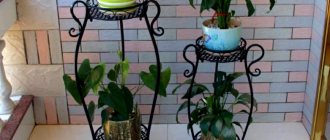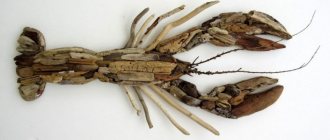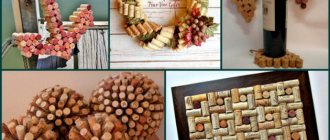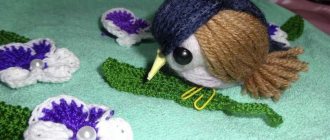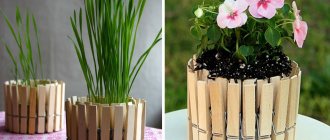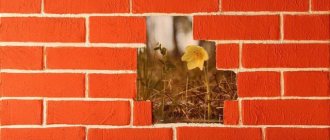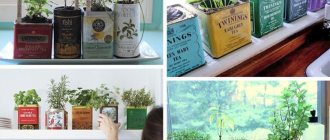Home » Building a house » Do it yourself
Vladimir 03/17/2020
19360 Views
Growing plants and creating extraordinary flower arrangements requires different types of containers. Some of them can be found in your nearest store. But in most cases, their shape and design leaves much to be desired. Therefore, today we will master the technique of making flower pots with our own hands.
Shells, pebbles and other little things
This is a very easy-to-implement way to transform any, even the most ordinary and unattractive flower pot.
The best part is that this technology gives enormous scope for creativity and imagination: you can decorate pots in a marine style, in one color or using interesting color combinations, select decorative elements that fit perfectly with the overall style of the room, etc. Based on this simple method, you can create products that are completely different in style, texture and appearance. The technology for such decoration is very simple: you will need universal PVA glue or any other universal glue, a brush, a pot and the material with which you are going to decorate the pot. In some cases, for example, when using shells, the pot will look even more attractive if, after gluing the decor, it is coated with a colorless glossy varnish. If you have chosen large items for decoration, glue is applied to their underside and glued to the pot. In the case of small objects, it is more convenient to cover small areas of the pot with glue in order to place decorative elements on them.
If desired, the surface of the pot between the decorative elements can be primed with glue (you will get a transparent substance) or with decorative primers and putties of different colors and textures.
What do you need to make a paper planter?
The main “ingredient,” of course, is paper (newspapers, magazines, unnecessary notebooks). Several sheets should be left whole, and the rest should be cut into small pieces of approximately 10x15 cm.
In addition to paper, to make flowerpots you will need:
- balloon;
- a bowl or tray with plain water;
- PVA glue;
- scissors;
- mesh for decorating flower bouquets;
- a can of gold paint.
Instead of glue, you can use paste.
Planters made of branches or bamboo
Natural materials are the best way to decorate your interior, as they are naturally beautiful and environmentally friendly. One option for creating a flowerpot is a flowerpot made from reed or bamboo branches.
To do this you need to prepare:
- chopped straight branches or bamboo;
- twine;
- scissors;
- glue "Moment" transparent;
- dense coarse fabric (burlap, linen);
- plastic pot.
Operating procedure:
- Before you start tying the sticks together, they should be aligned so that the product looks aesthetically pleasing.
- Then we tie the branches together with twine along the edges (2-3 cm to the edge), pulling them tightly so that the fabric does not fall apart.
- Apply a layer of glue to the outer walls of the pot and glue burlap or linen evenly.
- We tie a cloth of sticks around the pot, and tightly tie the top and bottom parts.
- The flower pots can be additionally decorated with flowers made from twine or burlap, which will give the product a special effect.
Weaving from newspapers
How to make a flower pot out of newspapers? The process of creating it is similar to making flowerpots from willow branches . The only thing is that the paper must be properly prepared for work.
Preparation of blanks
To obtain strong “branches,” the newspaper must be twisted.
For this:
1The paper is cut into fairly wide strips 6-7 cm thick.
2Each strip is laid on a long knitting needle at an angle of 35-30°.
3We begin to wind the paper onto the knitting needle as tightly as possible, holding the tip of the newspaper with your finger for convenience.
4Glue the remaining edge so that we get a thin tube. One end should be slightly thicker than the other, so that in the future we can build it up by inserting one into the other. The length of the workpiece depends on the size of the future craft.
5 Remove the knitting needle from the tube and dry the glued area for 15-20 minutes.
6The resulting blanks can be immediately painted with gouache, watercolors, and acrylic paints. For these purposes, non-standard pigments are often used - for example, iodine, henna, basma, water-based wood stain, food coloring, etc. When creating patterns, ready-made products are coated with dye.
7To strengthen and protect from moisture, the finished pots are varnished. It is better to do this the first time at the preparation stage. The finished product is painted a second time.
We will not describe in detail how to weave flower pots from plastic bottles. The scheme of work is completely similar to weaving from newspapers or willow twigs.
Ready-made paper pots
Hanging flower pots are best used in rooms with sufficient light. If the room faces the shady side, it is better to grow indoor flowers on the window, where there is more light.
Methods of weaving from newspapers
A standard wicker flowerpot consists of a bottom, which is made separately, and sides. You can use any container as a form: from a bucket to a small jar.
There are many types of weaving. In difficult cases, several tubes are woven at once.
Paper weaving step by step
We'll stick to the simplest ones:
1First, you need to prepare a frame in the form of many rays emanating from the center of the bottom. For this you will need 12 tubes. They must be divided into 2 parts of 6 pieces and each of them must be secured with a clothespin.
2Fold both parts perpendicular to each other on a flat surface so that their intersection is in the center.
3Glue them together at the junction.
4Take a new tube, bend it in half and place the bend under any of the 4 crossed parts.
5 We begin to gradually braid them using the “rope” method, alternately twisting each part.
6After 2 rows have been intertwined, we begin to twist not several pieces at once, not 4, but 2 tubes at a time.
7 After a few more rows, we begin to braid each tube.
8When the bottom is ready, we begin weaving the wall. Take a suitable jar or other container and place it in the center of the bottom. To prevent the light form from moving out, it is better to fill it with something heavy, for example, stones.
9 Using a knitting needle, we make a small hole in the weaving next to the stand tube and insert a new piece of rolled newspaper into it, slightly moving the edge outward.
10The second tube must be placed under the adjacent rack.
11To prevent the rolled paper piece from breaking when bent, it is carefully pressed down and then placed perpendicular to the bottom.
12We begin to alternately braid each of the racks using 2 tubes.
13To make the workpieces softer, they must be kneaded periodically with your hands.
14The distance between them must be the same, so the racks must be adjusted periodically, installing them in the right place.
16The remaining ends of the tubes are intertwined vertically through several rows using a knitting needle. Excess ends are cut off.
17To ensure that the finished weaving looks neat, at the end of the work, the racks are threaded using a knitting needle into several rows of weaving and trimmed.
Dark-colored pots always heat up more in the sun, so they can only be used for heat-loving plants.
DIY flower pot decor at home
You can decorate flower pots, both plastic and clay, with your own hands, using any available materials that you can even find at home, or buy specially.
To work, in addition to the pot, jar or bucket itself, you will also need sandpaper, surface degreasing liquid (solvents, white spirit, acetone, nail polish remover), glue, acrylic paints.
Suitable materials for decoration:
- beautiful fabric
- jeans
- sackcloth
- paper
- newspapers
- twine, threads
- paper napkins
- twigs from trees
- pencils
- CDs
- broken plates and cups
- eggshell
- shells
- clothespins
- buttons
- cereal
- lace and knitted napkins
- bugles
- pebbles
- nail polish
- paints
- and much more that your imagination suggests. And mine told me to use the rhinestones left over from the diamond mosaic.
Preliminary preparation
Before gluing decorative elements to the surface of the pot, it must be prepared in order to get rid of existing coatings and patterns on plastic jars, excess fat and ensure better adhesion of the material. Otherwise, this may result in cracking of the paint layer, delamination and deformation.
- Therefore, first of all, the pot needs to be cleaned, washed and dried.
- Then sand it thoroughly using sandpaper.
- Degrease the surface with any solvent.
- In most cases, it is advisable to coat it with white acrylic paint or paint of a different color to match the material being decorated.
I made a selection of the most interesting, in my opinion, photos of pot decor, which I took from freely accessible Internet sources. I didn’t do my own master classes, but only selected videos with interesting ideas.
Interestingly, many ideas and technologies are similar to those that we considered for decorating Easter eggs.
Using scrap materials
You can make flowerpots from scrap materials, for example, from plastic bottles, buckets left over from under paint. Everyone can do them. The process of making containers for flowers from a bucket comes down to the following steps:
- Holes are made in the bottom using a knife or drill.
- The handles are removed.
- The surface is masked by applying PVA or gypsum, newspapers.
- The decoration of the pot is done using buttons or shells.
When making a flowerpot from plastic bottles, the following manipulations are performed:
- The bottle is cut in half with a utility knife. The cut can be wavy or even.
- A CD is glued to the lid of the eggplant, which acts as a stand.
- The resulting structure is coated with paint. You can draw patterns and ornaments on it.
You can also cut out the top of an eggplant laid on its side. The result is an unusual, spacious design. After this, you can start decorating the pots.
Making a pot with your own hands
Naturally, you can buy a pot for creativity, and those who want to create it themselves - let's create! A purchased container for flowers may not always be the way you want it to be. A pot you create with your own hands is a unique thing that your friends won’t have. And besides, any little thing made with your own hands will be an amazing gift for friends or relatives.
Clay container. Clay is the main material from which a container for planting plants is made, so let’s start with it. Clay has always been associated with the potter's wheel, but that is long gone. We will need:
- Clay.
- Bake.
Before you start work, decide on the shape and size of the container so as not to make a mistake. The next step is to soften the clay to make it more pleasant and convenient to work with.
- Separate a small piece and roll it into a ball. Thoroughly flatten the resulting figure onto the base on which you are making the pot. You have prepared the bottom.
- Form a rope about 1 cm thick. It should surround our prepared bottom. In the same way, make several more strands to make a pot of the size you need.
- Leave the product for a couple of days for it to completely harden.
- Fire the product.
So the first option is ready. This is the easiest and most interesting way to create something unusual.
Woven pot. Another interesting option would be a pot that you weave yourself. To do this, you don’t need to have any professional skills in weaving, since everything is much simpler than you think. For this work you will need:
- Twigs.
- Sackcloth.
- Twine.
- Glue.
- A small cylinder as a base.
Before starting work, prepare the twigs. They should not be too long so as not to waste time cutting them. Prepare rods equal to the height of the cylinder. You can take a little more to cover it.
- Take some string. Tie all the finished rods of the same size together and secure with twine.
- Lubricate our base (in this case the cylinder) with glue, then glue on a small piece of burlap.
- Apply glue to the burlap in the same way, and then glue the resulting twig structure.
- You can fasten everything with twine. To achieve the most striking look, tie the resulting container with decorative ribbon. So the thing will be more extraordinary and unusual.
This pot is ideal for plants that have small and weak roots. For example, for decorative flowers.
Master class on working with papier-mâché (video)
MK using this papier-mâché technique:
- Prepare paper cut into small pieces in advance. Some crafters claim that torn paper is better than cut paper, but it's really a matter of personal preference. To strengthen it, you can use a bandage; it also needs to be cut. It is convenient when the paper is of different colors. For example, if you take a newspaper, then layers with text will alternate with layers on which bright advertisements are printed. The difference in color will help you figure out where you need to add the next layer and where it already exists.
- Prepare a sufficient amount of PVA glue. The glue can be diluted with tap water, then it penetrates the paper faster. The maximum dilution ratio is 3 parts glue to 1 part water; the more water used, the looser the product becomes. Too much water will cause the sculpture to “float” and lose its shape. For detailed and thin products, undiluted glue is better. In addition to PVA, you can use glue for paper wallpaper or homemade paste. The instructions for the glue contain information about its toxicity; you need to choose an environmentally friendly glue without a strong odor, because it will take a long time to glue.
- For the paste you need starch and boiling water. Pour starch into a cup, add boiling water and stir until smooth. The thickness of the paste should resemble sour cream. After finishing the work, the paste must be immediately washed off from the cup, after hardening, this will be problematic.
- If the frame mold then needs to be removed from the finished product, you need to lubricate its surface with vegetable oil, Vaseline or any greasy substance to prevent the mass of paper from sticking to the frame.
- If you do not plan to remove the mold, it can be covered with PVA or paste. After the preparation of consumables is completed, you can begin creating the sculpture.
The technique for performing the work is very simple, it is easy to do it yourself if you have patience. The paper is applied layer by layer, the glue is distributed with a large brush. You need to dry the layers either until dry or semi-dry.
Step-by-step making of pots for indoor flowers
You can easily and simply make your own pots for indoor flowers by following the instructions:
Fold a 10 m piece of rope in half.
Fold in half again.
And fold it in half again. We try to make everything work out smoothly. One end is made from threads folded in half.
At the second end we cut the part of the rope that is folded in half. As a result, on one side you get everything with the ends of the rope, and on the other side there are kinks in the rope. It is from this edge that hanging flower pots begin to be made.
From the end of the rope where the kinks are, we form a loop. A DIY hanging flower pot will have a middle at this location.
Thread a ring through the middle
Flower pots in flowerpots are hung on such rings, so it is important that it is of good quality.
Using a short piece of rope, make a loop at the bottom and wrap the rope under the ring. We thread the lower end of this rope into a loop and tighten it, pulling out the upper end of the rope
We trim the ends evenly.
We hang the ring on the wall, cabinet or kitchen unit at eye level. Can also be attached to a stable wooden board.
We determine the height of our hanging pots with our own hands for indoor flowers. On every two ropes we make a knot in this place. All four knots should be at the same level of the rope.
We retreat down to the height of the flowerpot itself from the first knots and determine the weaving pattern. All ropes must be placed in sequence. We take one rope from one line and the second from the second, and tie knots.
From the second and third lines we also take a rope and make a knot at the same level.
From the third and fourth lines we also take a rope and make a knot. We do the same with the remaining ropes. All knots must be sequentially at the same level so that the flowers look beautiful on the wall in such a pot.
We retreat below the same distance as between the first nodes. Here we have exactly the same weaving pattern - we tie four more knots in succession.
We insert our flower pot into the middle, which we will hang on the wall for fitting. We tie all the lower ends into one knot so that the flower pot is beautifully and evenly located in our flowerpot.
We cut the ropes, leaving a small tail, so that the flowerpot turns out beautiful. You can thread wooden beads onto the ends, then the wickerwork looks even more beautiful. You can also choose decorations and accessories depending on the place where you need to hang the flower. Take a pot with your favorite indoor plant, insert it into a flowerpot made of rope (or twine) and hang it on the wall.
Making crafts:
1. Fold the square in half - fold the top edge with the bottom.
2. Fold the square in half again - fold the left edge with the right.
3. Fold the top edge towards the resulting center of the square towards you.
4. Fold the folded half up.
5. Turn the model over.
6. Fold the lower left and right corners of the figure to the marked point
7. Fold the bottom edge of the model towards the folded edges.
8. Turn the figure over.
9. The flower pot for the applique is ready.
ps Don't be greedy, share the link to this craft with your friends!
Papier-mâché flowerpot
If the collection of flowers is large, purchasing flowerpots for each of them is quite expensive. When using improvised means, you can not only save a lot, but also get the most unusual decorative products. An original papier-mâché floor or hanging planter can complement a collection of flower pots.
Papier-mâché cups
Paper-adhesive mass is an excellent material that is easy and simple to work with.
But it is better to use a painted and varnished product for planting flowers that are not irrigated with water.
So, let's describe the process of creating papier-mâché flower pots:
1We will glue the plastic container so that moisture does not dissolve the paper over time. You can use a mayonnaise bucket.
2The container must first be degreased and then coated with a primer for better adhesion (you can use regular glue).
3First, prepare the paste. For half a liter of cold water you will need a large spoon of flour. Brew it to a boil, remembering to stir so that no lumps form.
4Tear thin paper or newspapers into pieces measuring 4x4 cm. It is not recommended to use scissors and cut them - only with your hands.
5Mix the paste thoroughly with the torn paper.
6To strengthen it, you can add wood glue to the solution. A more homogeneous mass is obtained by adding chalk to the paste.
7You can also mix the composition with gypsum, clay or sawdust.
8When using cardboard, it must be torn into smaller pieces and first soaked in plain water, and then mixed with paste. The resulting mass is first squeezed out by hand, dried and ground on a grater.
9We begin to slowly, pressing tightly, apply the solution to the jar. We don't touch the bottom.
10Our product will take several days to dry.
11Using papier-mâché, you can simply decorate any container using the decoupage technique. To do this, blanks in the form of flowers or figures are prepared from paper and glue. Then they are glued to the flower pots and varnished. The gaps between applications can be decorated with decorative paper napkins.
12 Paint the work with watercolors, gouache or acrylic. The final stage is varnishing to impart water-repellent properties.
13The flowerpot in the shape of a stump looks very original. To do this, dried papier-mâché is painted first with black paint, and then with a second layer of strokes of ocher dye.
Finished papier-mâché work
How to make a children's house with your own hands: from wood and other materials. Drawings with dimensions | (80 Photo Ideas & Videos)
Suitable materials
All paper materials are suitable for papier-mâché: newspapers, paper towels, toilet paper, napkins, egg cartons. All paper for work is torn by hand or cut into pieces measuring 1.5 × 1.5 or 2 × 2 centimeters. Egg trays are used to create mass for modeling.
Newspapers
The most popular and classic material is newspapers. This is a fairly inexpensive and accessible material for making crafts and toys. Old unwanted newspapers will serve well for creating dishes, fruits, flowers, and toys for children. This is a soft, comfortable and high-quality papier-mâché material.
Paper
White paper is used in the papier-mâché technique to make toys that do not require painting or are covered with a thin layer of paint. Typically A4 size office paper is used. White parts of blanks or toys are simply coated with a thin layer of varnish.
You can use corrugated paper, but it is used to make paper pulp for sculpting three-dimensional figures. Colored paint can stain your hands, so you need to wear gloves when working with it.
Toilet paper
Toilet paper is a good material for creating a modeling mass. Its pieces are soaked in water, squeezed out and starch and PVA glue are added. The result is a good adhesive mass from which you can form figures of animals, birds, hearts, mushrooms, make paintings and much more.
Egg trays
Egg trays are used for sculpting large products. To obtain a good mass for modeling, pour hot water into the egg trays and leave for a day.
When the entire mass is well dissolved in water, squeeze it out well using gauze or cloth and add paste.
From this mixture you can sculpt mushrooms, stumps, trees and other large objects. Paint after drying with regular watercolors.
Decorating flower pots: how to create a beautiful decoration
Clay pots are suitable for creating beautiful interior items, although plastic ones are no less beautiful. You should definitely treat them with several layers of acrylic so that when watering, water does not leak out and spoil the decor.
Any material is suitable for decoration. Let's look at the most common options.
Decoration with golden acrylic paints Source www.dizainvfoto.ru Decoration of a flower pot using pencils Source dekormyhome.ru/ Bright street composition Source realty.mail.ru
Paper
This is usually an intermediate option, used temporarily until a more suitable design is created. Anything will do except cardboard: even old newspapers, wallpaper, sheets of music, craft paper, A4 sheets.
The paper is glued to the sides, it is better not to touch the bottom. The paper is tied on top with decorative braid or twine, even if the material itself holds up perfectly.
The pot is covered with corrugated paper, for example, from the linings of cardboard boxes. The paper is glued into strips, after which they are varnished. Externally, such pots look stylish and are in no way inferior to ceramic ones.
Option for decorating a flower pot with paper Source www.greensmile.ru/
Colored primer for aquarium
First, the entire surface of the pot or its individual sections is smeared with glue and sprinkled with soil on top. After drying, you can paint it any color or leave it as is. The top of the soil is coated with varnish.
Decoupage
We open the pot with acrylic. Already on a dry surface, glue a beautiful design cut out of a thick paper napkin using PVA. After drying, the drawing is coated with acrylic varnish.
Instead of napkins, any images on paper will do. They are cut out, dipped in water, then blotted with a towel, coated with glue on the back side and glued. Decoupage made from lace looks elegant.
Paints
Different paints are suitable for decorating a flower pot: sprays or regular acrylic. To prevent paints from mixing, you need to use masking tape. Using a sponge or brush, various ornaments and designs are applied. They are varnished on top.
Painting a clay pot Source www.dizainvfoto.ru Design using decoupage technique Source vdome.club Design using buttons and other simple materials at hand Source flowers-for-home.narod.ru/
Mosaic
Any fragments and remains are used, including those from construction and repairs, pieces of ceramic tiles, pebbles, and buttons. The surface is treated with sandpaper, covered with primer, and glue on top.
After this, you can begin laying the mosaic, moving from bottom to top. You can lay pieces of material in stripes, various patterns, or you can cover the entire surface with a material that is uniform in color and texture.
Homemade flowers on the shelvesSource realty.mail.ru A simple decoration element - a bowSource www.pinterest.dk
Cereals and seeds
The surface is covered with several layers of acrylic paint, a pattern is applied and they begin to lay it out. To do this, a small area is smeared with glue and the selected type of cereal is applied. You can simply sprinkle it on the area coated with glue. The entire surface is treated in this way. At the end, the product must be secured with spray varnish.
Pot made of plasticine and cereals Source yandex.ru Original silver flower pot Source youtube.bonus-mobile.ru Beautiful flower pots with your own hands Source biznakenya.com
Decorating flower pots is not complete without egg shells. Shells in brown and white shades are suitable; acrylic paints are used to add additional picturesqueness. It is especially beautiful if the shell contrasts with the color of the surface of the pot.
The shells of boiled eggs will need to be carefully prepared: remove the inner film, place in a soda solution to degrease. Then you need to rinse and dry well.
Pasting is carried out in stages: first, a small area of the surface is smeared with glue, pieces of the shell are laid out on it with the convex side up and pressed lightly. You need to act carefully so as not to break the shells. This way the entire surface is covered.
If you outline patterns in advance, you can get beautiful ornaments. The remaining gaps between the mosaic pieces are filled with crushed shells, which are simply sprinkled on the surface covered with a layer of glue.
Decorative covering option for a flower pot Source vdome.club
The last step is to prime the resulting surface with PVA glue and dry it. If desired, you can paint the surface or leave it as is, but be sure to varnish the top to secure the decor.
Hyacinths in a cup pot Source dekormyhome.ru/ Corn pots Source stroitelcentr.ru
Decorating flower pots
A flower pot with an original design does not have to be made from scratch. You can also use standard flower pots or containers of suitable size. They can be painted with paints, covered with paper napkins or cloth.
Flower pots are made from macrome. Craftswomen who know how to hold knitting needles or a crochet hook in their hands can prepare knitted “clothes” for flowerpots. Lace, fabric, beads, buttons, coffee beans and cereals, etc. are also used for decoration.
An original idea using pencils
When decorating with eggshells, they are first degreased in a baking soda solution. After drying, the pieces are coated with glue and applied to the surface with the convex side.
If the distance between them turns out to be significant, small pieces are added to the gaps or the uncovered areas are covered with crushed shells. Then the product is coated with PVA glue, and after drying it is varnished.
Wooden pots
They look very authentic and original, and the wood is easy to process and repair. To work you will need a drill, hammer, chisel, jigsaw or saw, chipboard and a small log.
Excess parts are removed from the log. Then, using a drill, a series of holes are drilled at the same distance from the walls. Using a hammer and chisel, the holes are widened and the core is removed from the log.
A pot with thick walls is formed from the resulting workpiece. To prevent the tree from interacting with moisture, it is better to place a plastic pot inside and plant flowers in it.
Preparation of glue
A homemade paste is ideal for working with papier-mâché in eco-style. It can be cooked from starch or flour.
Paste recipe No. 1
Pour 5 cups of water into a heavy-walled saucepan. Bring it to a boil. Mix a quarter cup of flour with a cup of cold water in a bowl. Stir the resulting mass until all the lumps are separated. Now pour the mixture into the heated water in a thin stream. Cook for 2-3 minutes until thickened. When cooking the glue, do not forget to stir constantly.
Paste recipe No. 2
Dissolve 2 teaspoons of starch in one glass of water. After this, pour the mixture into a saucepan and, stirring constantly, wait until the mass becomes transparent and viscous. Let it cool down. Now you can use the paste in your work.
Paste recipe No. 3
There is a slightly different technology for preparing glue. Dissolve starch in water at room temperature and mix well. The consistency should be similar to sour cream. Stirring constantly, pour boiling water until the mass becomes thick, like jelly, and transparent. Now leave the paste to cool.
The paste quickly deteriorates, so it is better not to store it, but to use it immediately.
With care for the environment
It's a hot topic. All you have to do is not throw away identical plastic bottles, but make a whole system of hanging containers out of them. Budget-friendly and interesting. What do you think?
And the balcony is there too
They mentioned the garden and the apartment, but forgot about the balcony. We'll fix it now.
You can create several small planters and attach them to the railing. This will create the desired comfort and will certainly surprise the neighbors from the next house. Avoid bulky options
They will distract attention from other decorative elements and take up a lot of space. Neat curly ones will fit just right
Especially hanging ones.
The promised second part of the article. I want to do something. Especially for you, we have selected five simple options that you can implement with your own hands. This is in case there are no old things lying around, and all the stones are gone.
Animals
When creating these cute animal faces, you can make any shape you want! Make a cat, a hare, a dog. This is a great papier mache craft idea for beginners.
Crumple the newspaper into a ball and then glue it together. Cut two ears from recycled cardboard to fit the head.
Cover the ears with paper tape and then attach them to the head.
Repeat these steps to make different animal heads.
To prepare the paper mixture, mix 1 part flour with 2 parts water. Mix until there are no lumps left and add more water or flour until you are happy with the consistency - it should be similar to white glue.
Dip a strip of newspaper into the glue. Glue the strip onto the animal's head and repeat until the head is completely covered.
Let dry for at least 24 hours.
Now the fun part - drawing! Color the animal heads the way you like. Let dry completely and then place on a shelf or glue a small loop to the back to hang on the wall.
How to weave a flowerpot: where to start
A do-it-yourself flower vase made from scrap materials using the macrame technique is a beautiful and functional thing. You need to weave such a product according to the pattern. Experienced craftswomen can weave pots from twine according to their own pattern, but novice needlewomen are, without a doubt, recommended to weave pots according to a ready-made pattern. Do-it-yourself weaving from twine or other types of rope usually does not present any difficulties for beginners. The main thing is to strictly follow the pattern, and then a novice craftswoman can easily make a real masterpiece from ordinary rope with her own hands
Attention: you need to choose a rope from which it is convenient to weave, otherwise serious difficulties may arise during the work process. In order to make an original basket for indoor plants from scrap materials, beginning weavers will need:
- Weaving pattern. Schemes of varying levels of complexity can be easily found on the Internet and in specialized literature. A beginning craftswoman must soberly assess her capabilities and master the art of macrame weaving according to the principle “from simple to complex,” but not vice versa. Therefore, to begin with, it is recommended to take the simplest scheme. Before you start weaving flowerpots, it is recommended to practice a little in weaving basic macrame elements;
- The material from which the weaving will be made. This could be twine, an ordinary clothesline, decorative cords of different colors, or even flexible wires that have been used and are no longer needed;
- Sharp scissors. They are useful for cutting the rope in the right places. Also, the blade of scissors is convenient for untangling poorly tied knots;
- Decorative elements of the finished product. You can decorate the pots with wicker flowers, which will also be made using the macrame technique. Or you can decorate it with a decorative figurine of a bird, bee or butterfly. It all depends on what decorative elements are available at home;
- You will also need a pot for which the new planter is intended. You need to have a flower pot on hand while weaving in order to accurately determine the size. It is desirable that the color of the flowerpot and the color of the pot combine beautifully with each other.
need all the time
Do-it-yourself macrame flower pots: general description of work
- It is necessary to select a design and material for the work;
- Next, you should carefully study the diagram and (if any) detailed step-by-step instructions for making flowerpots;
- After this you should start weaving. A flowerpot can be of any shape, but it invariably consists of a bottom and sides. During weaving, it is recommended to tie the knots as tightly as possible so that the finished product is strong and does not sag under the weight of the flower pot;
- After the main part of the work is completed, you can begin decorating the product. However, it is not at all necessary to decorate a wicker pot, because a product made using the macrame technique is beautiful in itself, without additional decor. The main thing is to choose a weaving method that looks impressive.
Weaving flowerpots from twine with your own hands using the macrame technique: practical recommendations
- The wicker plant pot is very light in weight;
- It looks impressive;
- Unlike ceramic, wicker cannot break;
- It does not take up much space in the interior, so such flowerpots are an ideal solution in a room where there is cramped space and little space.
master the macrame technique
Caring for pots
A flower “dressed” in such a pot will look original in the interior of a living room, nursery or bedroom. Those who have a lot of indoor flowers can be advised to make a series of flowerpots made in the same style, but with minor differences. You can use a special stand
Attention: the stand for the flower pots must be reliable and stable, it must not wobble under any circumstances
basic weaving skills
Features of the pots
A flower pot and a regular flower pot are somewhat different from each other. Typically, a flowerpot is understood as a flowerpot that has a non-standard design. It can be used alone or as a beautiful shell for a pot.
There are no drainage holes in the flowerpot, so it can serve as a decoration not only for the garden or home window sills, but also become a decorative element for bedside tables, shelves, furniture walls, or hang from the ceiling, becoming the highlight of the interior.
How to choose material?
Today, almost all specialized hardware stores offer a wide range of various home decor and garden decorations. However, even with this abundance of products on offer, not everyone will be able to choose the most suitable models for their site or home. The only way out of this situation is to create an original and unusual product with your own hands.
No matter what anyone says, anyone can make the brightest decorative flowerpots from the most ordinary materials. You just need to use your wits and give free rein to your imagination.
Using improvised objects, you can turn your wildest ideas into reality. For decorating a garden plot, old household items that contain home comfort and the warmth of a family hearth will do. This is the very highlight that attracts the eyes of others.
In almost all closets there are old household items that no one has used for a long time. But you shouldn’t send them for recycling. It’s best to see if they might still be suitable for creating compositional flower pots. For example, using an ordinary plastic bottle and thread, you can create unusual bright pots for growing any types of plants. The same goes for old clothes.
Before choosing material for decoration, you need to decide in what conditions the pot will be located. For outdoor use, it is preferable to use materials that do not interact with a damp environment.
People who are exclusively engaged in growing and breeding indoor plants often create decorations for their pets from the most ordinary materials. In addition, they try to choose a special design of pots for each individual flower. For example, orchids or succulents will look very laconic in a pot with decorations made from vines or pumpkin seeds.
You can create an unusual flower arrangement from a variety of objects, for example, from an old teapot, a leaky watering can, or even a torn shoe. Floor cleaning rags will allow you to make the wildest fantasies of a self-taught decorator come true.
Types of flower pots
Flowers are grown in almost every home. This creates a beautiful, aesthetic interior, comfort, unity with nature. In addition, house plants enrich rooms with oxygen, which is of great importance, especially in a metropolis.
Flowerpots have different purposes according to the method of placement:
- floor planters are installed on special stands, sometimes multi-tiered;
- table pots decorate shelves, window sills, tables and cabinets;
- hanging flower pots, using ropes or wires, are attached to special hooks and suspended from ceilings and upper beams;
- wall planters are located in special holders attached to the wall.
Wooden flower pots
Wood also provides a fairly wide range of actions, various shapes and colors. Choose what you like best and create.
Master class: hanging wooden planter
This hanging planter will wonderfully complement your home interior. It’s quick and easy to do, and it won’t cost you a lot of money on materials either. The optimal solution for an apartment.
Necessary materials:
- Wooden plate and saw
- House plants and flowerpots
- Rope and metal ring
- Drill and sandpaper
- Paint and brush
Step-by-step manufacturing scheme:
Step 1: Making Wooden Squares
Consider how many tiers your flower stand will have (there are 4 here, but you can do more or less). Select the houseplants you want to place there.
Based on all this, cut out the required number of squares from the wooden plate.
- To do this, turn the pot upside down and place it on a plate, circle it and leave about 5 cm on the sides, thus determining the size of the square.
- Use a saw to make squares.
Step 2: Making holes for the pots
- You already have a circle drawn on the tree from the top of the pot, now you need to draw another one in the middle so that their centers coincide, but the diameter of the new one is about 1-2 cm smaller.
- This value depends on how quickly the pot you will be placing in the stand grows towards the top, and also you want the wooden square to be almost at the very top, or in the center of the pot.
- You can take another pot that is the same size as the stencil and trace it.
- Use a jigsaw to cut out this new circle. For convenience, you can first make a hole with a drill and, starting from there, work with a jigsaw.
- The pots should now fit inside the squares.
Step 3: Hanging Holes
At the corners of the squares you need to make holes for the rope so that they can be hung. To do this, use a drill with a diameter of up to 1 cm.
Step 4: Paint the tree
Using sandpaper, remove roughness and unevenness that formed after sawing and drilling. Now the wood can be painted or simply treated with an antiseptic. In this case, dark brown paint was used.
Step 5: Paint the pots
Pots can also be painted, if desired. Casual strokes of white paint look good on plain clay pots. You can skip this step.
Step 6: Putting it all together
In order to fasten the wooden squares together, we need a thick rope: cut 4 ropes of 180 cm each (for the given number of tiers). Stretch one rope into each corner hole of one of the squares and tie a knot at the end, this will be the lower part of the structure.
On each rope, tie another knot 25-30 cm higher than the previous one and thread the ropes into the holes of the next square. Check that everything is level and the second tier is clearly horizontal above the first, adjust the knots if necessary. The second tier is ready. Repeat these steps with the remaining tiers.
Step 7: Plant the Plants
A practical advantage of such a hanging stand is that water that may flow down after watering from the top plant will drip onto the bottom one. So a stand for the pot is needed only on the lowest tier (if you use it outdoors, you can do without stands at all).
You can also place coffee filters or similar water-absorbing materials in the bottom of the pots, this way the water can drain out but the soil won't fall out through the hole.
TIP: To prevent the bottom pot from falling off the stand if someone accidentally snags the string, superglue it to the pot.
Step 8: Transplant the plants into prepared pots.
If you glue the base of the lower pot before inserting it into the wooden square, it will look like the photo below. If you want the bottom pot to be inserted into the tree in the same way as the others, then first replant the plants, insert the pots into the holes in the tree, and only then glue the stand to the bottom one.
Step 9: Hanging
- To hang this structure, thread the ropes through a metal ring and tie a knot, or bend them over and tie another thin rope around them.
- Adjust the rope so that all tiers are horizontal and level.
This stand will perfectly decorate an empty corner in the apartment, just don’t forget that flowers need enough light.
A hanging stand is a wonderful solution for those who love flowers, but do not have enough space to display them.
Flower pots without bottom
- Cut out a circle from cardboard or thick paper, choose the diameter yourself, to fit your pot.
- We make holes every 2 centimeters on the contour. You can make them with an awl or knitting needle.
- We twist the tubes from the newspaper and insert them into the holes of our workpiece.
- Leave the “tail” under the circle 3 centimeters in size - it must be bent, but not glued.
- We put the pot on the cardboard and start weaving. We weave in a checkerboard pattern. We choose three-tier weaving, when we weave 3 sticks after 3 into the workpiece.
- We weave to the top edge of the pot, even a centimeter higher.
- We remove the pot. We close the top and bottom with a regular fold. We cut off all excess.
- Cover with a mixture of PVA glue and water in a 1:1 ratio.
- Then we coat it with varnish.
Planters for the garden
The main difference between a flower pot and a flower pot is the lack of drainage. Therefore, you need to select options so that you can freely remove pots with plants from them without damaging them. When making flowerpots for the garden with your own hands, you can take into account all the nuances of watering and removing plants from flowerpots.
Decorating a garden with hanging flowerpots located on arches, or building a multi-tiered version in the form of a staircase exhibition, is quite possible even for those gardeners who are not particularly friendly with applied arts.
How to crochet flower pots, and from what threads: diagrams with descriptions
Eye-catching flowerpots are preferably made of bright yarn, and there are no restrictions in the choice of texture. It is desirable, however, that it be acrylic or thin cotton.
The following scheme will do:
Pattern for knitting flower pots
So, if you still need a bottom, then you should start knitting with it.
If not, then you should start with a chain of air loops that matches the length of the bottom of the pot. This chain needs to be closed, after which, following the pattern, continue knitting upwards. In this case, you need to add loops in every third row.
A cross with a dash means that the hook is inserted exclusively under the back or front wall of the loop. You will get a nice finish at the bottom and top of the plant pot.
These are the kind of pots you can knit
